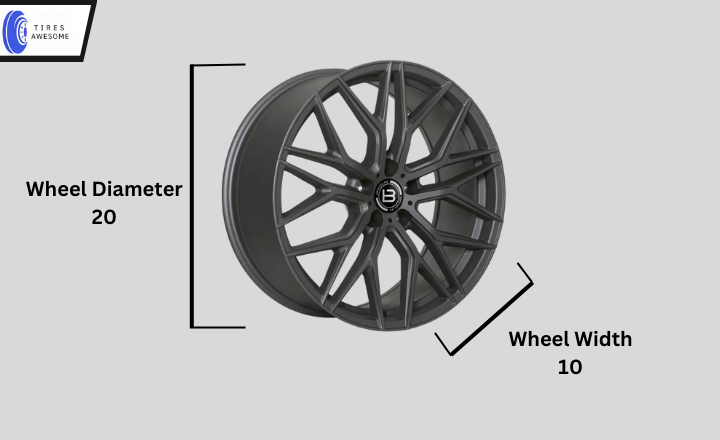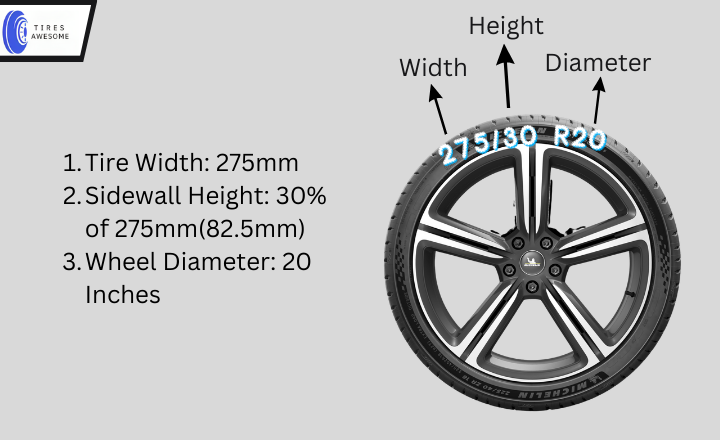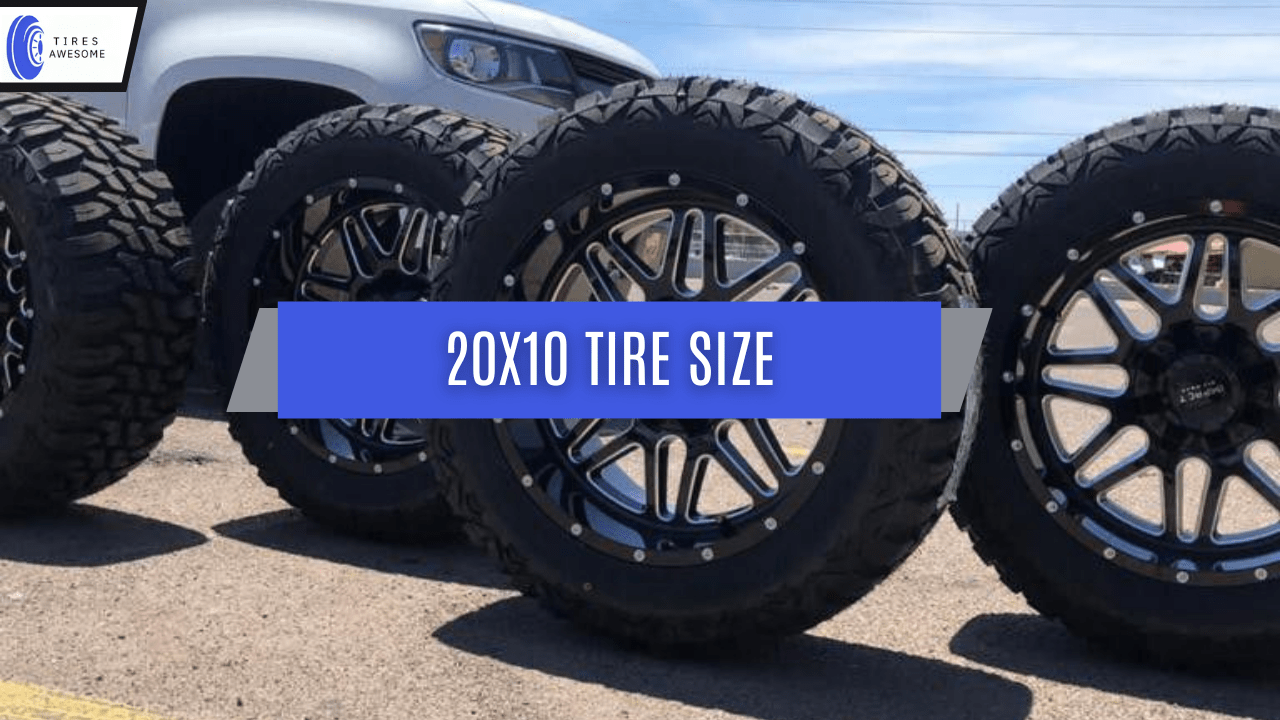Are you tired of seeing the same old, dull wheels on every car? If so, it’s time to upgrade to the sleek and stylish 20×10 tire size. Before you hurry to purchase new tires, let me, as a tire expert, help you know what fits this wheel size. The unique tire size is becoming popular among car lovers who want to impress with their cars. This article will talk about 20×10 size and assist you in picking the best tires for your car.
What Is 20×10 Wheel Tire Size Mean?
A 20×10 wheel is a type of Wheel with a diameter of 20 inches and a width of 10 inches. The 20×10 tires size provides a visually striking appearance while preserving optimal handling characteristics. A wider width allows for better traction and stability on the road, improving performance during turns and maneuvers.

What Tires Fit 20×10 Wheels?
The vehicle’s suspension setup is crucial in ensuring proper fitment and performance. The wheel offset must be considered as it affects how the tire sits within the Wheel well and its clearance with other suspension components.
We recommend considering a range of tires for 20×10 rims based on our expertise. Some suitable options include 275/30 R20, 275/35 R20, 275/40 R20, 285/30 R20, 285/35 R20, and 295/30 R20. These dimensions balance optimal handling characteristics and aesthetics while maintaining compatibility with your chosen wheel size.
Guide To Reading 20×10 Tire Size:
Here’s a simple guide to help you grasp these numbers and ensure a perfect fit for your wheels:
- This letter indicates the type of vehicle. The letter P stands for P-metric, meaning the tire is specifically designed for passenger vehicles such as cars, vans, SUVs, and similar automobiles.
- If you see the letters LT or L-metric on a tire, those tires suit light truck vehicles. Light trucks typically include pickup trucks and small cargo vans.
- The first letters before the slash indicate the tire’s width, typically millimeters. This measurement helps determine how well the tire fits on your vehicle.
- After the first set of numbers on your tire’s sidewall, there will be another letter denoting whether it is a radial (R), diagonal (D), or bias ply (D) tire.
- The aspect ratio represents the percentage of the tire’s height and width.
- Continuing after the second set of letters, you will find a numerical value indicating the tire’s diameter in inches.
Let’s look at the 275/30 R20 tire as an example. These numbers hold valuable information to help you make informed decisions about your vehicle’s tires.
The total width of the tire is 275 mm; the sidewall height is measured as a percentage of the width, so in this case, it would be 30% of 275 mm, which equals 82.5 mm. Moving on to the last number, R20 indicates that this tire is designed for wheels with a diameter of 20 inches.

What Is 20×10 Wheels For The Best Tire Size?
A larger tire with a broader width can increase traction and stability, especially in performance-oriented driving scenarios.
The 285/30 R20 is highly recommended for your 20×10 rim tire size, as it offers a perfect fit and a wide range of tire choices from different manufacturers. This particular size strikes an outstanding balance between performance and ride comfort.
What Is The Biggest Tire Size For 20×10 Wheel?
The largest tire that can fit on a 20×10 wheel is determined by factors such as the vehicle’s suspension setup, fender clearance, and wheel offset. Without extensive modifications, a tire size like 295/35 R20 may be considered the maximum size that could fit. It is highly recommended to consult with experts or professionals who specialize in customizing vehicles to avoid any rubbing or clearance issues.
What Is The Smallest Tires For 20 x 10 Wheels?
The recommended minimum tire size for a 20×10 wheel is 275/30 R20. Using smaller tires could be unsafe and affect performance. They might not fit the wheel width properly, affecting handling and grip. So, for the best performance and safety, always use the recommended tire size for a 20×10 wheel.
What Happens If You Put the Wrong Tire Size On A 20×10 Wheel?
Putting the wrong tire size on your car’s wheels can lead to a range of problems that affect both performance and safety.
- The sensors that monitor tire pressure, speed, and other important information may need to be fixed with the correct tire size. This can lead to inaccurate readings and potential damage to your vehicle.
- Using proper tire sizes can positively impact fuel efficiency. The incorrect tire size may result in increased rolling resistance, which requires more energy from the engine to move the vehicle.
- Another issue when using tires is an increased risk of wheel damage. Mounting tires outside their recommended range can strain the Wheel rims excessively and cause them to crack or bend during operation.
Can I Change The Tire Size Without Changing The Rims?
Yes, changing tire size without changing rims is possible if you maintain the same internal diameter. This means that you can mix and match tires in terms of height. When it comes to width, there needs to be more flexibility. Ensuring the tire can fit into the wheel wells without touching or scraping is essential.
Changing tire sizes can affect several aspects of your vehicle’s performance, including speedometer accuracy, fuel efficiency, and handling. It is always recommended to consult a professional or refer to your vehicle’s manufacturer’s guidelines before making any changes to tire size.
Why Should I Change The Tire Size?
When considering whether or not to change tire sizes, there are three main factors to consider:
Aesthetics:
Changing the tire size can significantly alter the appearance of your vehicle. Depending on the size and style chosen, it can give it a more aggressive or sporty look. This could be a central selling point if you wish to customize your car’s appearance.
Performance:
Changing the tire size can impact your vehicle’s performance, such as acceleration, braking distance, cornering ability, and fuel efficiency. Larger tires may improve off-road capability but reduce fuel economy. Smaller tires may enhance agility but compromise stability at high speeds.

Costs:
Besides purchasing new tires, additional expenses may include potential modifications required for proper fitment and recalibrating speedometer readings to ensure accuracy. The change might also affect routine maintenance costs like rotations and alignments.
Final Thoughts
The 20×10 tire size is designed to fit onto a wheel with a diameter of 20 inches and a width of 10 inches. This size is commonly used for larger vehicles such as trucks and SUVs, providing enhanced stability and traction on the road. Ensure the tire size fits the Wheel’s specifications for fit and performance. Choosing the right size tires for your car can improve its control, safety, and driving experience. Talk to a professional or check your car’s manual when considering replacing or upgrading your tires.
FAQs
Will A 275/55 R20 Fit A 20×10 Rim?
Yes, a 275/55 R20 can be fitted on a 20×10 rim, although it is not the usual tire size recommended. Note that, depending on your vehicle, this fitment may require modifications.
How Much Of A Tire Can Fit On A 20-Inch Rim?
For a standard passenger vehicle, a tire with a width ranging from 225 to 275 millimeters and an aspect ratio between 40 and 55 can fit comfortably on a 20-inch rim. These basic rules might change based on the vehicle’s specific model and situation.
Will 305/55 R20 Fit 20×10?
No, a 305/55R20 tire will not fit on a 20×10 wheel. The first number in the tire size (305) represents the tire’s width in millimeters. The second number (55) is the aspect ratio, which indicates the height of the sidewall as a percentage of the width. The last number (20) denotes the diameter of the Wheel in inches.

